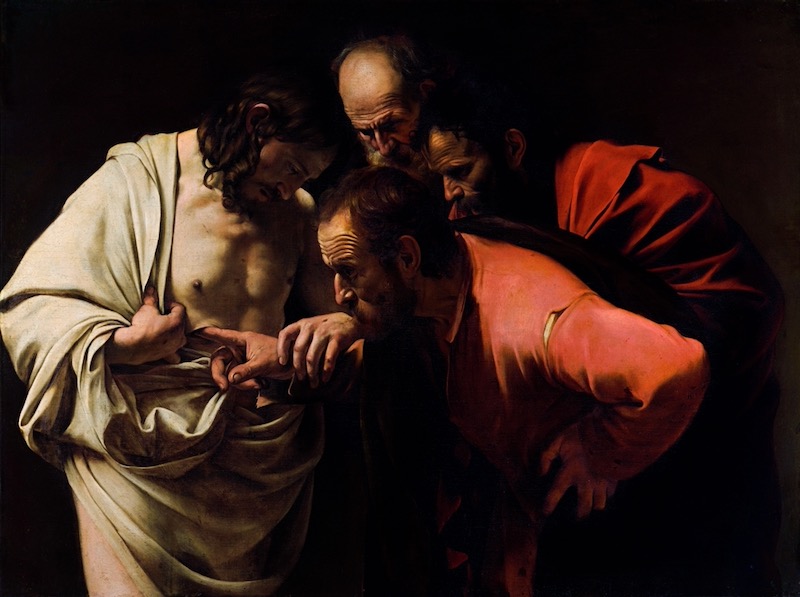Thomas appears three times in John’s gospel and on each occasion, he stands out from the other disciples. It’s he, for instance, who impetuously, and poignantly, exhorts the others to follow Jesus to Jerusalem, despite danger to their own lives. “Come, let us die with him.” It’s he who cheekily complains to Jesus at the Last Supper that he’s not making himself clear enough. “Lord, we do not know where you are going: how can we know the way?” And in this gospel, Thomas stands out from the others by refusing to accept that Jesus is risen until he can see him for himself.
This reluctance to accept the word of the others, without the evidence of his own eyes, has earned Thomas the most misleading moniker of all time. ‘Doubting Thomas’ is lodged in the Christian imagination as the archetypal sceptic.
But this moving episode at the end of John’s gospel isn’t about doubt at all, but faith. Or, better, it’s about the relationship between justified doubt and genuine faith. So far from being the odd man out, the petulant empiricist, Thomas represents all of us who both believe and, at times, doubt. Even more importantly, this episode has much to teach us about both how and what we believe.
The clue is that this episode comes at the very end of what was the original text of John’s gospel. John has quite deliberately used it, in other words, as a climax. Remember how he begins his gospel with the majestic Prologue: “In the beginning was the Word and the Word was God”. Well, Thomas is the first person, at what was originally the very end of the gospel, to address Jesus as God. With his “My Lord and my God”, the purpose of the gospel, namely, as John himself says to his readers, “that you might believe that Jesus is the Messiah, the Son of God”, is seen to be fulfilled, in Thomas. Thomas, in other words, isn’t the archetypal doubter but the archetypal believe. The phrase used of many individuals, “he saw, and he believed”, runs like an antiphon throughout the gospel of John, and it applies quintessentially to Thomas, as well as to every one of us.
So, what exactly does the story of Thomas teach us about faith? First, it makes it resoundingly clear that, as in all matters of truth, intelligent questioning and enquiry are essential, not inimical, to faith. Faith isn’t a crutch for the credulous, or a comfort blanket for the fearful: on the contrary, it requires real courage to live in the presence of mystery. And faith points us in the direction of the ultimate mystery, the source of existence itself, which remains permanently beyond our intellectual reach. But here’s the twist about the nature of faith: rather than empowering us to reach out to the God, faith renders us receptive to his reaching out to us.
Again, in this episode, John is showing us that faith isn’t a private possession. Nor is it something we acquire by effort of will or exercise of intellect. And it’s certainly not the reward of virtue: it is itself a virtue, but not an acquired virtue, like courage or temperance. No, here John shows us that faith in the Risen Christ is given, and given to us, not to me; that’s to say, it is given in the context of and is therefore an attribute of a community, that is, the Church. Indeed, he shows us that faith is the antithesis of that existential anxiety arising from the thought, which invades the peace of mind of every thoughtful human being, that we are ultimately alone.
The Church has always known herself to be a living community of faith, the bearer, from generation to generation, of a tradition, a truth that has been received and handed on. “That which I have received, I handed on to you”, says St Paul.
Of course, modernity – officially, at least - is impatient of tradition. The Enlightenment confidently predicted that reason would displace tradition as a matter of course, the two being mutually exclusive. That they were manifestly wrong hasn’t prevented their prediction seeping into the secular mind-set of the West, giving rise to the view, contrary to all evidence, that to engage in free enquiry, you must first be freed from the constraints of tradition.
But that sundering of reason and tradition was a departure not only from ancient wisdom but also from universal human experience, and not just in matters of faith but in every part of life. Without tradition, learning of any kind is impossible. You must be taught if you want to learn; and in all fields of culture and learning, immersion in traditions of learning and living is indispensable for excellence and even a prerequisite for originality of thought. All concepts and ideas have a history. What else are libraries for, but to preserve ideas and understanding?
And this is true, a fortiori, of Christian thought and understanding. To believe is, for a Christian, to be immersed in a tradition of faith which has been safeguarded and transmitted by the living Church, “the Catholic faith, which comes to us from the Apostles”, as we say at Mass (or as we used to say in the previous less imperfect English translation of the liturgy).
But this gospel also makes it plain that the truth in which we believe and to which we give witness isn’t a relict, much less a relic, of the past, but a truth we know here and now. And we witness - or we fail to witness - to the Risen Lord, whom we know here and now, not with words only, but with our lives. The first witnesses to the Resurrection spoke not just of what they’d seen, but of what had happened to them because of what they’d seen.
In the end, Thomas’s profession – “My Lord and my God” – is as much a profession of love as of faith. And this is because faith, like love, is a kind of knowledge that draws us deeper into what’s known and loved. Which is why, for us, the goal of life isn’t merely to know about God, but to know and love God Himself, just as we are known and loved by Him. In the end, both belief and knowledge, even of God, have clipped wings: both are tethered to the earth, sterile even, without love.
And, finally, to emphasise that it is neither the hard-won reward of effort nor the inexorable force of empirical evidence, faith is not so much cognition as recognition. It isn’t that we see something others don’t see – that’s the territory of the visionary and the seer; rather, it’s to see with different eyes entirely, just as one who loves and is loved sees the beloved (and everything else, for that matter) with different eyes. Some of the early Church Fathers spoke of faith as enabling us to see with the “spiritual senses”. The third century theologian, Origen (185-254), speaks of the “faculties of the heart” and the 20th century Jesuit theologian, Bernard Lonergan, spoke of faith as “knowledge born of religious love”.
To believe, then, is not primarily to have seen and touched the Risen Christ, but to have been seen and been touched by Him. In the end, to believe is to be overwhelmed by a presence, to be overwhelmed by the presence of Love Itself, as Thomas was.



 Loading ...
Loading ...
What do you think?
You can post as a subscriber user ...
User comments (0)